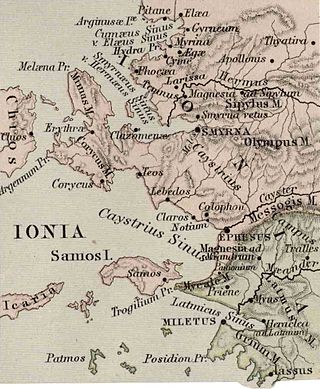
Colophon was an ancient city in Ionia. Founded around the end of the 2nd millennium BC, it was likely one of the oldest of the twelve cities of the Ionian League. It was located between Lebedos and Ephesus. Its ruins are south of the town Değirmendere in the Menderes district of Izmir Province, Turkey.

In antiquity, Paeonia or Paionia was the land and kingdom of the Paeonians or Paionians.
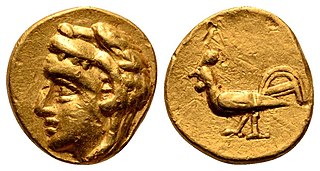
Dardanus or Dardanum was an ancient city in the Troad. It was sometimes called Dardania, a term used also for the district around it. Pliny the Elder called it Dardanium. It appears in other sources indirectly as well. The city-ethnic, or appellation of a person from Dardanus, is Dardaneus. Its coin legends are DAR and DARDAN. Its localization is securely marked by an inscription naming itself on the site.
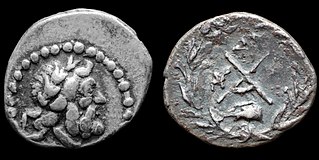
Dyme, or Dymae, was a town and polis (city-state) of ancient Achaea, and the most westerly of the 12 Achaean cities, from which circumstance it is said to have derived its name. The location of Dyme is near the modern Kato Achaia.
Sulusaray or Çiftlik, in Antiquity and the early Middle Ages known as Sebastopolis or Heracleopolis (Ἡρακλειούπολις), is a town in Tokat Province in the Black Sea region of Turkey. It is the seat of Sulusaray District. Its population is 4,383 (2022). Sulusaray is about 68 km from the center of Tokat, and about 30 km from Artova town. The site is situated on a plain surrounded by mountains and the Çekerek river runs near it. The mayor is Necmettin Coruk (AKP).
Elaea was an ancient city of Aeolis, Asia, the port of Pergamum. According to the Barrington Atlas of the Greek and Roman World, it was located near the modern town of Zeytindağ, İzmir Province, Turkey. The ruins of the silted port's breakwater can be seen on satellite maps at 38°56'35.54"N 27°2'16.34"E.
In Greek mythology, Pyraechmes was, along with Asteropaeus, a leader of the Paeonians in the Trojan War.
Siris was an ancient city of Magna Graecia, situated at the mouth of the river of the same name flowing into the Tarentine gulf, and now called the Sinni.

Heraclea, also Heracleia or Herakleia, was an ancient city. It was situated on the Gulf of Taranto between the rivers Aciris and Siris. The ruins of the city are located in the modern comune of Policoro in the Province of Matera, Basilicata, Italy.
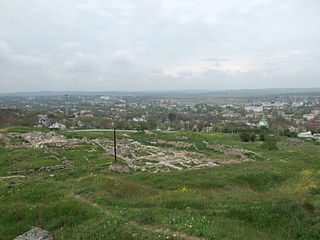
Myrmēkion or Myrmecium was an ancient Greek colony in the Crimea. The settlement was founded in the eastern part of the modern city Kerch, 4 km NE of ancient Panticapaeum on the bank of the Kerch bay near the cape Karantinny. The settlement was founded by Milesians in the first half of the 6th c. BC.

Greek colonisation refers to the expansion of Archaic Greeks, particularly during the 8th–6th centuries BC, across the Mediterranean Sea and the Black Sea.

Siro-Paeonians or Siropaiones were an ancient Paeonian tribe inhabiting the ancient city of Siris and the Strymon plain. They were one of eight (Herodotus) or ten (Thucydides) tribes of Paeonia. They were situated from the Bisaltae and Odomanti to the south, Sinthi to the north, the Strymon to the east, Maedi to the west, and a mountain chain separating them from Crestonia. Their capital was Siris (Serres). They were defeated by Persian general Megabazus. They were expelled by the Persians to Asia Minor, where they are assumed to have founded Serraepolis.
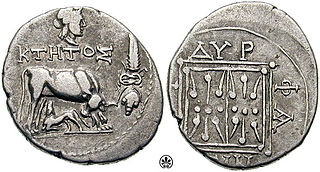
Illyrian coinage which began in the 6th century BC continued up to the 1st century of Roman rule. It was the southern Illyrians who minted the first coins followed by the northern Illyrian during the Roman era. Illyrian coins have also been found in other areas apart from Illyria, such ancient Macedonia, Italy, Greece, Asia Minor and Egypt.
Hermaion or Hermaeum (Latin) was a location in ancient Mysia, which formed part of the border between the city-states of Lampsacus and Parium. It was probably the same place as Hermoton, mentioned by Arrian, and may have been the site of a village or town. It was located near Çınardere, Turkey.
Potami or Potamoi was a fortified port on the coast of the northeastern part of ancient Paphlagonia. According to Arrian, it was 150 stadia to the northeast of Stephane, but according to others only 120.
Timolaeum or Timolaion was a town on the Black Sea coast of ancient Paphlagonia, at a distance of 40 or 60 stadia north of Climax and 100 to 150 stadia from Cape Carambis.
Chadisia, also Chadisius or Chadisios (Χαδίσιος), was a town of ancient Pontus, not far from the coast on a river of the same name. Hecataeus, quoted by Stephanus of Byzantium, speaks of Chadisia as a city of the Leucosyri, that is, of the group the Persians called the Cappadocians; and he says, "the plain Themiscyra extends from Chadisia to the Thermodon." Menippus, in his Periplus of the two Ponti, also quoted by Stephanus, says: "from the Lycastus to the village and river Chadisius is 150 stadia, and from the Chadisius to the river Iris 100 stadia."
Cerasus or Kerasous was a town of ancient Pontus, on the Black Sea coast, a little to the west of Trapezus. The Ten Thousand, in their retreat, came to Trapezus, and leaving Trapezus, "they arrive on the third day at Cerasus, an Hellenic city on the sea, a colony of the Sinopeis, in Colchis." The Anonymous geographer of Ravenna places Cerasus 60 stadia east of Coralla, and 90 west of Hieron Oros, and on a river of the same name. The name, and possibly the population, of the town were translated to Pharnacia in the Hellenistic era.
Coralla or Koralla was a town of ancient Pontus on a cape of the same name. It is placed by Arrian, and the anonymous author of the Periplus, 100 stadia east of Philocaleia, and Philocaleia is 110 stadia east of Tripolis, a well-known position.

Paeonians were an ancient Indo-European people that dwelt in Paeonia. Paeonia was an old country whose location was to the north of Ancient Macedonia, to the south of Dardania, to the west of Thrace and to the east of Illyria, most of their land was in the Axios river basin, roughly in what is today North Macedonia.










